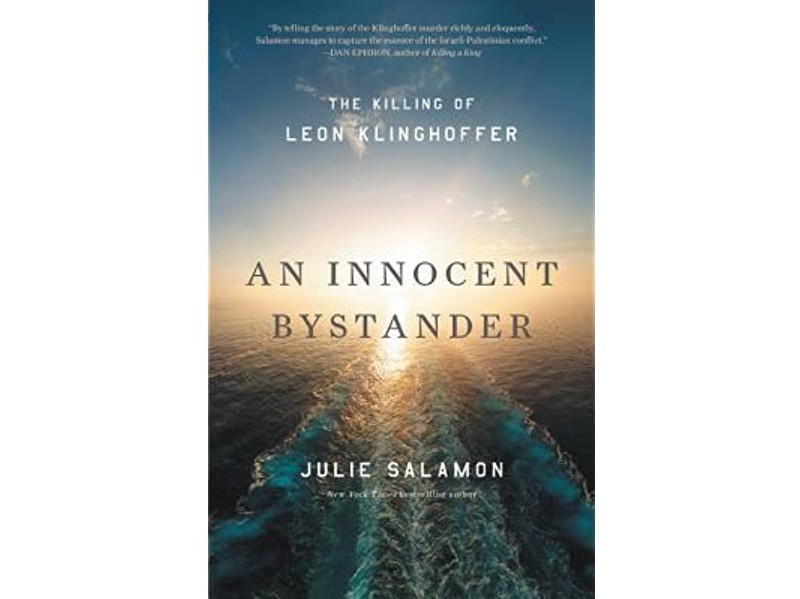Terrorism disproportionately influences politics. As Matti Friedman wrote in the New York Times on the eve of Israel’s most recent election, the Second Intifada irrevocably changed the trajectory of Israeli politics. “No single episode has shaped Israel’s population and politics like the wave of suicide bombings perpetrated by Palestinians in the first years of the 21st century,” Friedman argued. Similarly, Steven Brill demonstrated in The Atlantic how 9/11 forever changed the American political imagination, shaping national debates on security, borders and policing. Amplified by media narratives, around-the-clock news and, as George Will once remarked, “the pornography of grief,” terrorism captivates.
Julie Salamon’s latest book, An Innocent Bystander, is a refreshing reminder of terrorism’s enduring legacy on societies far beyond the act itself. The book follows the story of Leon Klinghoffer, a disabled American Jewish tourist, murdered by Palestinian Liberation Front (PLF) terrorists aboard the Achille Lauro, an Italian cruise ship, in 1985. Filled with evocative themes from terrorism on the high seas to criminal trials and international politicking, An Innocent Bystander transcends the murder itself, aiming to contextualize the broader implications set in motion by Klinghoffer’s murder. Foreshadowing the “War on Terror” with its attendant modern implications, Salamon interweaves a cascading narrative, linking the Achille Lauro, American media, terrorism trials and Klinghoffer’s ascension into popular consciousness.
Underlying Salamon’s narrative is the ordinariness the Klinghoffer family exuded. “The Klinghoffers were an American family, innocent bystanders to someone else’s war,” Salamon writes. Following the tragedy, they became the quintessential “poster children” of terrorism for America. Remarkably, Salamon writes, against the backdrop of rising urban violence, the Klinghoffer saga’s resemblance to a spy novel eclipsed all other news coverage.
An Innocent Bystander is equally a compelling work of social memory and terrorism’s broader imprint upon society. Tucked within the latter half of the novel, Salamon examines terrorism’s afterlife. Reminiscent of recent 9/11-inspired plays, such as Come From Away, in later years, Klinghoffer’s murder inspired the San Francisco Opera to commission a work, The Death of Klinghoffer, based on the hijacking. Moreover, two made-for-television movies sought to resurrect the drama, all while Philip Roth incorporated a nod to Klinghoffer in his book Operation Shylock.
No doubt the ingredients for such drama were there. However, for all inherent evocative themes throughout the book, its structure and organization, at times, fails to capture the tense atmosphere of the hijacking. Rather than reconstructing an entire chapter exclusively on the attack, Salamon diverts readers’ attention by prematurely jumping to regional politics, the PLO’s ejection from Lebanon and Ronald Reagan’s ascent as U.S. president. The narrative’s disjointed nature, culminating in Klinghoffer’s murder in Chapter 4, is ultimately anti-climactic. Spliced within this span are also redundant biographical sketchings from tangential characters. For example, seven pages in the second chapter are dedicated to Reem al-Nimer, the PLF commander’s second wife.
Salamon’s narrative structure is once more convoluted surrounding the eventual capture of the hijackers. Although Salamon succeeds in drawing readers into the high-paced American interception of the perpetrators aboard an EgyptAir Boeing 737, the chapter uncharacteristically ends by springboarding readers into former U.S. senator James Abourezk’s founding of the American-Arab Anti-Discrimination Committee (ADC), and the Jewish Defence League’s alleged role in the murder of ADC employee Alex Odeh. Only after these issues are addressed does Salamon return to the unfolding crisis between American and Italian forces at the Sigonella air force base.
Notwithstanding certain narrative shortcomings, Salamon’s retelling of Klinghoffer’s murder evokes a deeper, almost communal sense of horror and hopelessness Jews have increasingly become attuned to. In part, this stems from Salamon’s initial motivations to write the book. As she confesses in the book’s acknowledgements, it was originally entitled Klinghoffer’s Daughters, intended to narrowly detail an American perspective in a “suspenseful, heart-wrenching and intellectually engaging” fashion.
READ: SHALVA IS AN INSPIRING STORY OF PERSEVERANCE
Indeed, in expanding the book’s scope, Salamon succeeded in magnifying a deeper historical truth about the nature of anti-Semitism. As Salamon writes, the extent of the Klinghoffers’ version of “sentimental” Zionism amounted to viewing Israel merely as “a place to plant a tree in honour of someone who had died.” The superficiality of identity amongst the Achille Lauro’s Jewish passengers, nonetheless, did not remove them from being prime targets of violence. They discarded any potentially damning object liable to expose their religion. Chai necklaces as well as B’nai Brith cards sank to the bottom of the Mediterranean Sea in a desperate attempt to collectively cleanse their owners’ Jewish identities. This, perhaps, is the most compelling, though unpondered, aspect of An Innocent Bystander.
Although Salamon likely completed the book prior to the most savage illustrations of violent anti-Semitism in American history in Pittsburgh and Poway, Calif., it is impossible for contemporary readers to ignore seeing parallels. Perhaps, most presciently, An Innocent Bystander is a reminder that whether Jews live in Israel or the Diaspora, whether they are ardent Zionists or anti-Zionists, their Judaism remain a common denominator for bigotry.
“The Jewish passengers felt an ingrained response, the fear of anti-Semitism lurking,” Salamon writes shortly after describing the hijacking. That sense is once more crawling up the backs of American Jews today.
However, not all is lost.
As Poway’s Rabbi Yisroel Goldstein maintained in the New York Times following the attack on his congregation, it served as “a reminder that my ancestors gave their lives so that I can live in freedom in America; and a reminder, most of all, to never, ever, not ever be afraid to be Jewish.”









